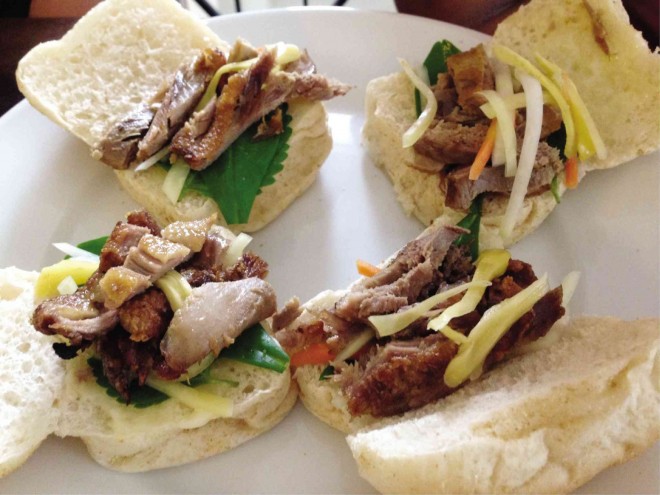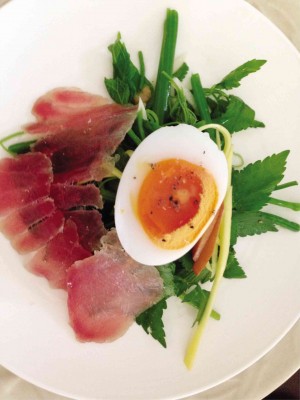
Is it really possible to give an unbiased review of Purple Yam? The short and incontrovertible answer is no; and not just because I believe it’s impossible to give a purely objective assessment of any restaurant.
Purple Yam is especially sacrosanct; it’s hallowed ground. When Romy Dorotan and Amy Besa announced their plans to bring back home their Brooklyn-based restaurant—successor to probably the most important Filipino restaurant outside the country for some time, Cendrillon in Soho—the news felt like a shot of adrenaline in the chest: finally, some new life in a city that was plagued by too many franchises and chain restaurants serving the same kind of food.
Advocacies
Besides, I’m too close to Besa and Dorotan. I share many of Besa’s advocacies, especially that of preserving the traditional foodways of the Philippines and introducing Filipino food to an international audience. I’ve always been a fan of Dorotan’s cooking, both in his restaurants or when he takes over private kitchens in Oxford or Brighton in the US.
At the same time, I don’t think it would be fair to give the restaurant a miss just because I know the couple well; I’m friends with a lot of chefs and I wouldn’t be able to write about much if I had to abstain every time an acquaintance opens a new place.
After Dorotan leaves to return to Purple Yam in Brooklyn, Purple Yam Malate will have chance to grow, slowly, into what it should be: an independent entity, doing something different for the Philippines from what its Brooklyn sibling does for the American culinary scene. Filipinos don’t have to be introduced to Filipino food; they have to rediscover it.
The past few weeks the converted historical house has been bustling with the “food mafia,” all of whom are in touch with the mainstream food scene abroad and its new obsession with farm-to-table cuisine, heirloom fruits and vegetables, local sourcing, and foraging for lesser-known indigenous produce.
This is what’s interesting about Purple Yam Malate. I think that the emphasis on the local constrains Dorotan’s talents a little: You won’t find here the nori-taco, a fried piece of seaweed wrap that contains a jubilant mix of vegetables; though you can have fried wonton skin parcels.
Breaking the rules just a bit is when his food truly shines. The pumpkin pancakes were very pleasant, with langka compote and a local passion fruit honey. But it was when he sneaked out a jar of homemade quince jelly he had brought into the country that the flavors truly sparkled.

Well-paced menu
Dorotan is always best when he is being slightly naughty and breaking the rules a bit; even at Cendrillon, the Filipino dishes he served up were always a departure from orthodoxy. The adobo that was introduced to the Soho public was thickened with a squeeze of coconut milk, a known but uncommon variant of the standard recipe.
We went through a well-paced Sunday brunch menu, mostly savory except for the pancakes, culminating in garlic fried rice and home-cured tapa and tocino, which were excellent; and there was a selection of interesting vinegar to go with it, including a lovely, very mellow 10-year-old aged sap variety.
Dessert was a light, cooling halo-halo with brewed coffee on the side. The company was good, the room light and airy, and acquaintances poured in through the door: foodies, friends of friends, and some of the old Malate crowd.
All in all I had a wonderful time and I felt the price was just about right; but feedback from other customers has been mixed, to my surprise (though I usually try to tune out other people when reviewing). But perhaps they had come under the mistaken impression that they were there to dine in a restaurant.
In the weeks that it has been open, people have come to Purple Yam to pay respects to the ideals it stands for: local, sustainable, organic Philippine food über alles, and it’s been one big party. Now it’s time to work. When it settles down, Purple Yam Malate will have to stand or fall on its own merits as a restaurant.
Fair price
Some people will find P2,500 per head a fair price to pay for the enormous lengths the restaurant goes to, to procure fascinating and obscure local ingredients. Some may see it as preposterously expensive for rustic, homely flavors and preparations.
The restaurant has the advantage of being able, at least within parameters, to evolve and come into its own; just as its clientele will be a more general public who will in turn have to manage their expectations and either be satisfied or disappointed.
I can think of very few food ventures in recent memory that have been started with intentions quite as noble. But whether or not this translates into a financially tenable, conceptually whole and a sustainable addition to the city’s dining scene, is yet to be seen.
In the end, it’s the food, and not the ideas about food, that people come back for, that makes a restaurant.
Purple Yam is at Bocobo cor. Nakpil, Malate; tel. 5233497. Weekends only by reservation.











































